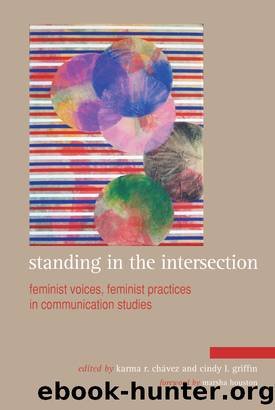Standing in the Intersection by Karma R. Chavez Cindy L. Griffin

Author:Karma R. Chavez, Cindy L. Griffin [Karma R. Chavez, Cindy L. Griffin]
Language: eng
Format: epub
ISBN: 9781438444918
Barnesnoble:
Publisher: State University of New York Press
Published: 2012-10-11T00:00:00+00:00
Once again, we want to be unambiguous. We point out Johnson's focus on race over gender not to suggest that Johnson is in error; rather, we are simply suggesting that as a scholar engaging in intersectional work, Johnson had to choose his focus and his method of analysis, and while his book admirably addresses the intersections of race, class, sexuality, and gender, in this instance and elsewhere, he tends to foreground race. Indeed, he is both explicit and reflexive about such choices, writing in an earlier chapter that âalthough theories of performativity focus primarily on the performativity of gender, I engage a discussion about the performativity of race.â24
When engaging in intersectional work, such choices are not only inevitable, they are also necessary in order to put intersectional thinking into practice, to develop a method of analysis. Indeed, as we learned from feminist standpoint theorists25 and the postmodern turn, all writing necessarily reflects a perspective; it is not possible to take a âgod's eye viewâ of the world either in our thinking or in our actual methods of analysis. Our disagreement with Sloop, then, is with his characterization of Johnson's work as more consistently intersectional than Halberstam's. Both Johnson and Halberstam provide examples of intersectional work that begin with two different foregrounded nubs: for Johnson, questions of race; for Halberstam, questions of sex/gender. Both Johnson's and Halberstam's works are powerful and important intersectional analyses. The difference is what is at the forefront of those analyses. Because we believe that all work, even intersectional analysis, is always, already and inevitably focused in some way, the key difference between the two is one of focus and methodological practice rather than which is more authentically intersectional.
Both Showden's critique as well as our discussion of Sloop's work thus return us to a key methodological question about intersectional workâa question to which all rigorous work must attendâwhich provisions are attended to, when, and why. The third-wave feminist scholars and activists discussed above who deemphasize gender promote and engage in work that addresses an âindefinite number of issues and cultural analysesâ in an effort to understand the intersection of gender, race, sexuality, geography, and nationality. However, as we have illustrated, in this effort to âdo it all,â26 these scholars and activists sometimes intimate that sex/gender is somehow less important or less worthy of attention than other axes of power, while also, often, failing to provide justificatory explanations for the method they use in the practice of intersectional analyses and activism. Indeed, we submit that because these scholars and activists have not explicitly addressed the methodological issues of âwhich provisions should be attended to, when, and why,â they inadvertently reiterate a sexist system wherein traditionally âwomen's issuesâ are considered of lesser importance than other social justice causes. Thus our concern goes beyond a lack of clarity regarding what makes such work âfeministâ; we maintain that when scholars do not make explicit and reflexive choices regarding the axes of power to which they will attend, they may inadvertently and
Download
This site does not store any files on its server. We only index and link to content provided by other sites. Please contact the content providers to delete copyright contents if any and email us, we'll remove relevant links or contents immediately.
On the Front Line with the Women Who Fight Back by Stacey Dooley(4800)
The Rules Do Not Apply by Ariel Levy(4795)
The Lonely City by Olivia Laing(4713)
Bluets by Maggie Nelson(4437)
The Confidence Code by Katty Kay(4166)
Three Women by Lisa Taddeo(3327)
Not a Diet Book by James Smith(3302)
Inferior by Angela Saini(3213)
Confessions of a Video Vixen by Karrine Steffans(3212)
A Woman Makes a Plan by Maye Musk(3178)
Pledged by Alexandra Robbins(3106)
Wild Words from Wild Women by Stephens Autumn(3047)
Nice Girls Don't Get the Corner Office by Lois P. Frankel(2975)
Brave by Rose McGowan(2765)
Women & Power by Mary Beard(2692)
Why I Am Not a Feminist by Jessa Crispin(2670)
The Girl in the Spider's Web: A Lisbeth Salander novel, continuing Stieg Larsson's Millennium Series by Lagercrantz David(2648)
The Clitoral Truth: The Secret World at Your Fingertips by Rebecca Chalker(2635)
Women on Top by Nancy Friday(2494)
